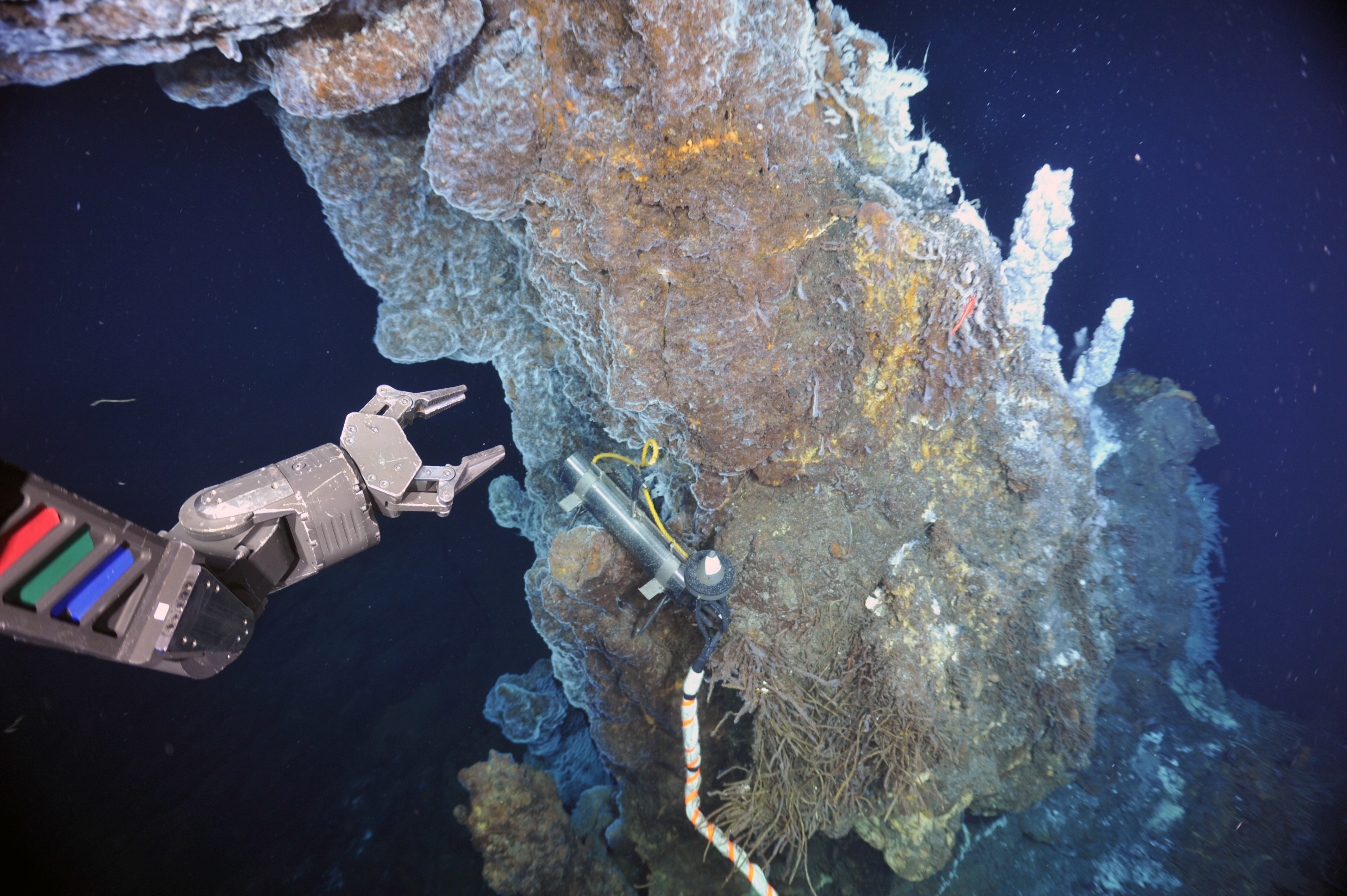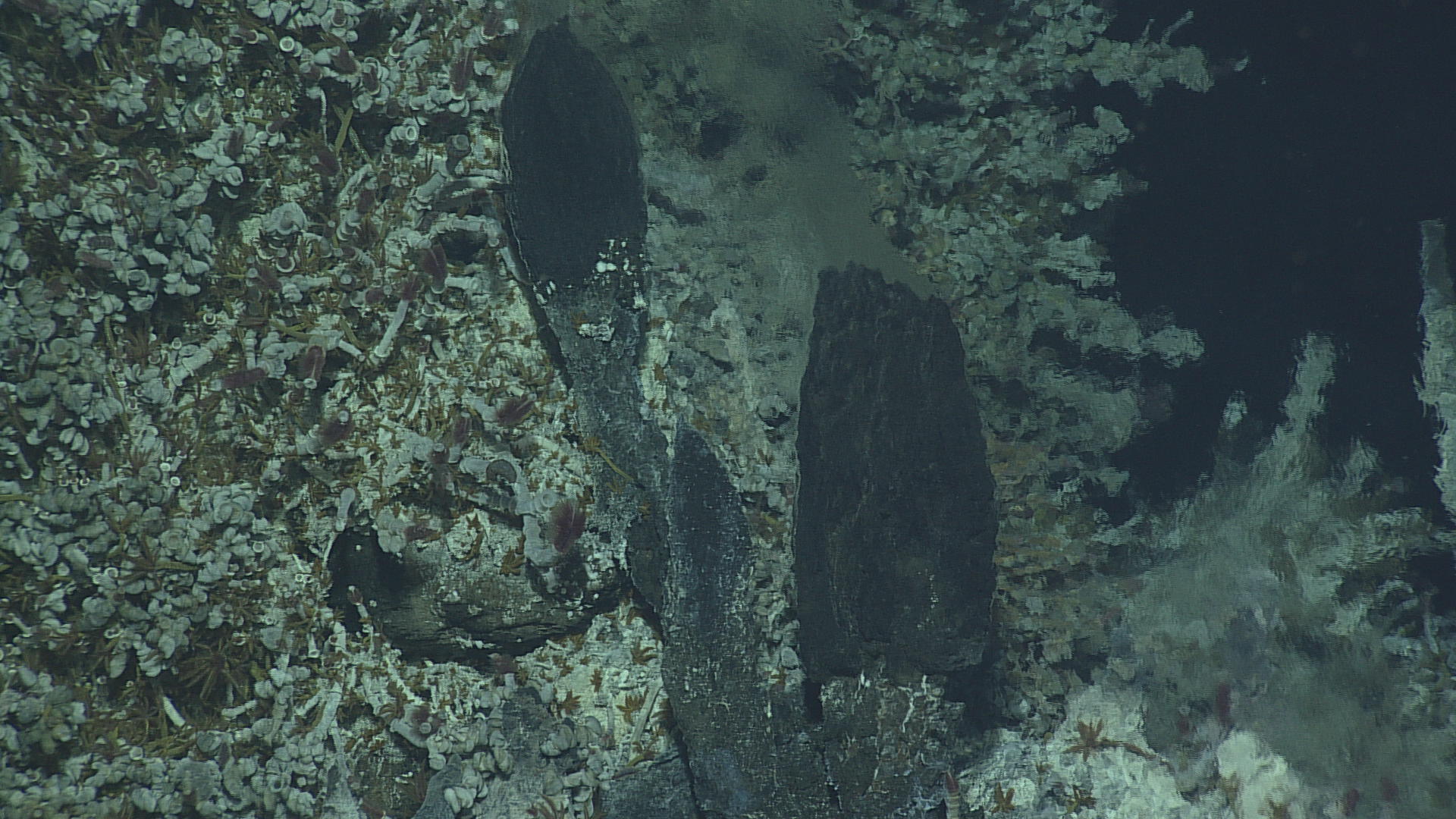Image Archive









The orifice at the base of the hydrothermal chimney called Mushroom is marked by a strong jet of high temperature hydrothermal fluid. Sulfide worms, scale worms and limpets are bathed in a mixture of the high temperature fluid and seawater. Credit: UW/NSF-OOI/WHOI, V18.

The anhydrite chimney 'Diva' visited with the ROV ROPOS during the VISIONS'14 program. This is an extremely CO2-rich vent with temperatures measured at 294°C (561°F) in July.

The ~ 4 m tall chimney called Inferno in the ASHES hydrothermal field sprouts a very young (< 2 year old) fragile beehive. The beehive structure is composed of very fine-grained sulfide minerals and anhydrite. Lush assemblages of tube worms, palm worms and limpets grow on the outer walls of the edifice. VISIONS '13, LEG 4. Photo credit: NSF-OOI/UW/CSSF

A resistivity-temperature probe, developed by Dr. Marv Lilley at the University of Washington, was deployed into a 270°C actively venting orifice on the chimney called Escargot. Resistivity is an analogue for chlorinity. Some of the vents in the International District are boiling, causing release of very gas-rich, low-salinity fluids. This instrument, recovered on ROPOS dive 1638, was deployed on a small ledge on the structure a few weeks previously with power provided by batteries in the titanium housing. The orange-white taped cable leads to the wand that is inserted into the chimney (not shown in this image). The white, feathery material on the outside of the chimney is filamentous bacteria, supported by low-temperature diffuse fluids that waft up the side of the chimney. Photo credit: NSF-OOI/UW/CSSF

High-temperature, near-boiling fluids jet from small spigots on the top of the metal-sulfide, black-smoker chimney called El Guapo (the handsome one) in the International District Hydrothermal Field. VISIONS '13, Leg 4. Photo credit: NSF-OOI/UW/CSSF

Small sulfide chimneys vent high temperature fluids at the base of the Mushroom sulfide edifice. Dense tubeworm (red plumes), palm worm (brown red plumes), and limpet macrofaunal assemblages completely cover most of the edifice. Credit: UW/NSF-OOI/CSSF. V13.

ROPOS collects vent chimney sample

A young smoker near the base of the suflide edifice called 'Mushroom' emits particle-poor, shimmering water at temperatures >100oC. Tube worms, palm worms and limpets bathe in diffusely flowing fluids that vent out of the porous chimney walls and mix with the surrounding, nearly freezing seawater. A high definition camera will be installed at this site providing real-time live imagery in 2014. (VISIONS '13 Dive R-1614) Photo credit: OOI-NSF/UW/CSSF
- Anemone
- Animal
- Arthropod
- ASHES
- Axial
- Axial Base
- Axial Biology
- Axial Caldera
- Bacteria
- Basalt Lava
- BEP
- Biofouling
- biolgoy
- Biology
- Camds
- Camera
- Camhd
- Central Caldera
- Ciliates
- Cnidaria
- Coastal Biology
- Crab
- Deep Profiler Mooring
- Dive Highlights
- Eastern Caldera
- Echinoderms
- Endurance Array
- Engineering Team
- ENLIGHTEN 10
- Exploratorium
- Fish
- Geology
- HD Camera
- HPIES
- Hydrate Ridge
- Hydrates
- Hydrophone
- Hydrothermal Vents
- Illustration
- Inshore 80 Meters
- Instrument
- International District
- J-BOX
- Jason
- Jellyfish
- Junction Box
- K12
- Lava
- Mollusk
- Moorings
- Nodes
- Nudibranch
- Octopus
- OOI
- Oregon Offshore
- Oregon Offshore 600 m
- Oregon Shelf
- Oregon Slope Base
- People
- PN1B
- PN1D
- Polychaetes
- PPSDN
- Primary Node
- RASFL
- ROCLS
- ROPOS
- ROPOS Dives
- ROV Team
- RV Revelle
- RV Sikuliaq
- RV Thompson
- Salp
- Sample
- SC13
- Science Team
- Sea Cucumber
- Sea Star
- Sea Urchin
- Seafloor
- Seismometer
- Sensors
- Shallow Profiler Mooring
- Shark
- Shipboard
- Shore Station
- Slope Base
- Smoker
- Soft Coral
- Southern Hydrate Ridge
- Sponge
- Squid
- Students
- Students & Guest Participants
- Tmpsf
- Tubeworms
- VISIONS 11 Leg 1
- VISIONS 11 Leg 2
- VISIONS 11 Viewers
- VISIONS 13
- VISIONS 14
- VISIONS 15
- VISIONS 16
- VISIONS 17
- VISIONS 18
- VISIONS 20
- VISIONS 22
- VISIONS 23
- Visualization
